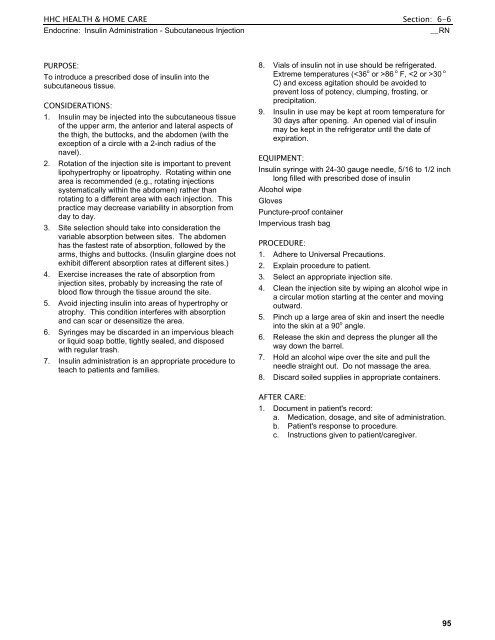HHC Health & Home Care Clinical Policy And
HHC Health & Home Care Clinical Policy And
HHC Health & Home Care Clinical Policy And
Create successful ePaper yourself
Turn your PDF publications into a flip-book with our unique Google optimized e-Paper software.
<strong>HHC</strong> HEALTH & HOME CARE Section: 6-6<br />
Endocrine: Insulin Administration - Subcutaneous Injection __RN<br />
PURPOSE: 8. Vials of insulin not in use should be refrigerated.<br />
To introduce a prescribed dose of insulin into the<br />
subcutaneous tissue.<br />
CONSIDERATIONS:<br />
1. Insulin may be injected into the subcutaneous tissue<br />
of the upper arm, the anterior and lateral aspects of<br />
the thigh, the buttocks, and the abdomen (with the<br />
exception of a circle with a 2-inch radius of the<br />
navel).<br />
2. Rotation of the injection site is important to prevent<br />
lipohypertrophy or lipoatrophy. Rotating within one<br />
area is recommended (e.g., rotating injections<br />
systematically within the abdomen) rather than<br />
rotating to a different area with each injection. This<br />
practice may decrease variability in absorption from<br />
day to day.<br />
3. Site selection should take into consideration the<br />
variable absorption between sites. The abdomen<br />
has the fastest rate of absorption, followed by the<br />
arms, thighs and buttocks. (Insulin glargine does not<br />
exhibit different absorption rates at different sites.)<br />
4. Exercise increases the rate of absorption from<br />
injection sites, probably by increasing the rate of<br />
blood flow through the tissue around the site.<br />
5. Avoid injecting insulin into areas of hypertrophy or<br />
atrophy. This condition interferes with absorption<br />
and can scar or desensitize the area.<br />
6. Syringes may be discarded in an impervious bleach<br />
or liquid soap bottle, tightly sealed, and disposed<br />
with regular trash.<br />
7. Insulin administration is an appropriate procedure to<br />
teach to patients and families.<br />
Extreme temperatures (86 o F, 30 o<br />
C) and excess agitation should be avoided to<br />
prevent loss of potency, clumping, frosting, or<br />
precipitation.<br />
9. Insulin in use may be kept at room temperature for<br />
30 days after opening. An opened vial of insulin<br />
may be kept in the refrigerator until the date of<br />
expiration.<br />
EQUIPMENT:<br />
Insulin syringe with 24-30 gauge needle, 5/16 to 1/2 inch<br />
long filled with prescribed dose of insulin<br />
Alcohol wipe<br />
Gloves<br />
Puncture-proof container<br />
Impervious trash bag<br />
PROCEDURE:<br />
1. Adhere to Universal Precautions.<br />
2. Explain procedure to patient.<br />
3. Select an appropriate injection site.<br />
4. Clean the injection site by wiping an alcohol wipe in<br />
a circular motion starting at the center and moving<br />
outward.<br />
5. Pinch up a large area of skin and insert the needle<br />
into the skin at a 90 o angle.<br />
6. Release the skin and depress the plunger all the<br />
way down the barrel.<br />
7. Hold an alcohol wipe over the site and pull the<br />
needle straight out. Do not massage the area.<br />
8. Discard soiled supplies in appropriate containers.<br />
AFTER CARE:<br />
1. Document in patient's record:<br />
a. Medication, dosage, and site of administration.<br />
b. Patient's response to procedure.<br />
c. Instructions given to patient/caregiver.<br />
95







